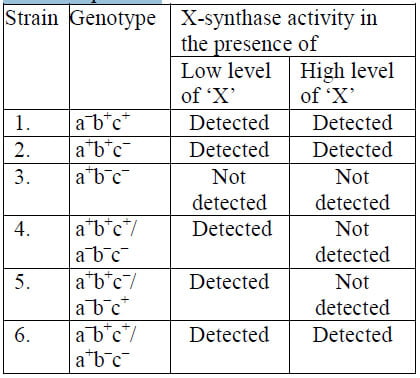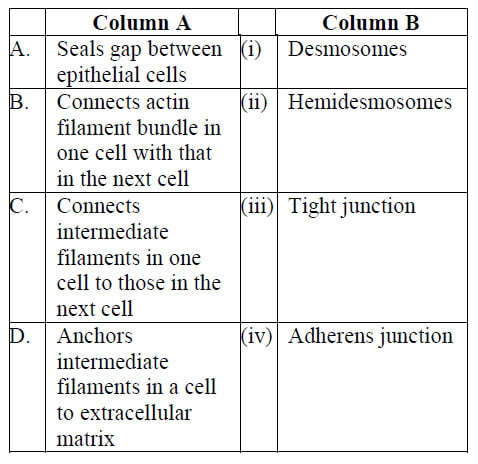Dear Students,
Welcome to Molecular Biology MCQ-14 (Molecular Biology for CSIR NET). This MCQ set consists of Advanced (Post Graduate Level) Molecular Biology Multiple Choice Questions with Answer Key. All these questions were taken from the previous year question papers of CSIR JRF NET Life Sciences Examination. These questions can be used for the preparation of Competitive examinations in Biology / Life Sciences such as CSIR JRF NET, ICMR JRF, DBT BET JRF, GATE and other University Ph.D Entrance Examinations. After marking your answers, please click ‘SUBMIT‘ button to see your ‘SCORE‘ and ‘CORRECT ANSWERS‘.
You may also like: Molecular Biology Notes | Molecular Biology PPT
(1). Which of the following is NOT a cell adhesion protein? (CSIR_2015_II)
(a). Cadherin
(b). Selectin
(c). Immunoglobulin (Ig) superfamily
(d). Laminin
(2). Which of the following is NOT a second messenger? (CSIR_2015_II)
(a). Cyclic GMP
(b). Diacylglycerol
(c). Inositol triphosphate
(d). Phosphatidyl inositol
(3). Membrane proteins are synthesized on endoplasmic reticulum and transported to various organelle membranes. One hypothesis for membrane protein sorting is hydrophobicity matching i.e., the proteins with a shorter trans-membrane portion would partition into thinner membranes.
You are given the following three observations
(A). It was found that trans-membrane portions of proteins in Golgi membranes are shorter than those in plasma membranes
(B). Presence of cholesterol increases the thickness of the bilayer
(C). The phospholipid composition of Golgi and plasma membranes are same
Which one of the following statements is correct? (CSIR_2015_II)
(a). Proteins in plasma membrane have longer trans-membrane portion than proteins in Golgi membranes
(b). Proteins in Golgi membranes have longer trans-membrane portion than proteins in plasma membranes
(c). Proteins of both Golgi and plasma-membranes have same length of trans-membrane portion
(d). Cholesterol is more in Golgi membrane than in plasma membrane
(4). The following are the statements about pyruvate kinase (PK). (CSIR_2015_II)
(A). ATP is an allosteric inhibitor of PK
(B). Fructose 1, 6 biphosphate is an activator of PK
(C). ADP is an allosteric inhibitor of PK
(D). Alanine is an allosteric modulator of PK
Which of the above statement(s) are true?
(a). A, B, C
(b). A, B, D
(c). B, C, D
(d). only A
(5). A practical class was going on where the students were demonstrating ATP synthesis in vitro using active mitochondria. Some students added one of the following to their tubes
(A). Dinitrophenol (DNP), an uncoupler
(B). Mild acidification of the medium
(C). Glutilferone, that permeabilizes both the membranes
(D). An outer membrane permeable H+ quencher compound, Elila
In which one of the above, ATP synthesis will be detected? (CSIR_2015_II)
(a). A
(b). B
(c). C
(d). D
(6). You have labeled DNA in a bacterium by growing cells in medium containing either 14N nitrogen or the heavier isotope, 15N. Furthermore, you have isolated pure DNA from these organisms, and subjected it to CsCl density gradient centrifugation leading to their separation of light (14N) and heavy (15N) forms of DNA to different locations in the centrifuge tube. In the next experiment, bacteria were grown first in medium containing 15N, so that all the DNA made by cells will be in heavy form. Then these cells were transferred to medium containing only 14N and allowed the cells to divide for one generation. DNAs were extracted and centrifuged as above in the CsCl gradient. A hybrid DNA band was observed at a position located between and equidistant from the 15N and 14N DNA bands. Based on the above observation, which one of the following conclusions is correct? (CSIR_2015_II)
(a). Replication of DNA is conservative
(b). Replication of DNA is semi-conservative
(c). Replication of DNA is dispersive
(d). Replication by rolling circle mode
(7). Although ribonucleoside triphosphates (rNTPs) are present at approximately 10-fold higher concentration than deoxyribo-nucleoside triphosphates (dNTPs) in the cell, but they are incorporated into DNA at a rate that is more than 1000-fold lower than dNTPs. This is because (CSIR_2015_II)
(a). DNA polymerase cannot discriminate between dNTPs and rNTPs. But as soon as rNTPs are incorporated in the DNA chain, they are hydrolyzed due to the presence of 2’-OH group.
(b). DNA polymerase cannot discriminate between dNTPs and rNTPs. But as soon as rNTPs are incorporated in the DNA chain, they are excised by the proof reading activity of DNA polymerase.
(c). DNA polymerase efficiently discriminates between rNTPs and dNTPs, because its nucleotide binding pocket cannot accommodate a 2’-OH on the incoming nucleotide.
(d). DNA polymerase cannot discriminate between rNTPs and dNTPs. Since the rate of transcription in cell is 106 times faster than replication, it cannot compete with RNA polymerase for rNTPs.
(8). A hypothetical operon involved in the synthesis of an amino acid ‘X’ is ‘ON’ (transcribing) in the presence of low levels of ‘X’ and ‘OFF’ (not transcribing) in presence of high level of ‘X’. The symbols a, b and c (in the table below) represents a structural gene for the synthesis of X (X- synthase), the operator region and gene encoding the repressor– but not necessarily in that order. From the following data, in which superscripts denote wild type or defective genotype, identify which are the genes for X-synthase, operator region and the repressor.

The respective genes for ‘X’ – synthase, the operator region and repressor are (CSIR_2015_II)
(a). a, b, c
(b). c, a, b
(c). b, c, a
(d). b, a, c
(9). Physical attachment between cells is very important in imparting strength in tissues. Various physical cell junctions in vertebrate epithelial tissues are classified according to their primary functions. Enlisted below in column A is the major function of a particular junction and column B enlists cell junctions, but not in the same order.

Choose the correct combination. (CSIR_2015_II)
(a). A – (i), B – (ii), C – (iii), D – (iv)
(b). A – (ii), B – (iii), C – (iv), D – (i)
(c). A – (iii), B – (iv), C – (i), D – (ii)
(d). A – (iv), B – (i), C – (ii), D – (iii)
(10). Given below are events in the cell cycle. (CSIR_2015_II)
(a). Phosphorylation of lamin A, B, C
(b). Phosphorylation of Rb (Retinoblastoma protein)
(c). Polyubiquitination of securin
(d).Association of inner nuclear membrane proteins and nuclear pore complex proteins with chromosomes.
Which one of the following reflects the correct sequence of events in the mammalian cell cycle?
(a). a→b→c→d
(b). b→c→d→a
(c). c→a→b→d
(d). b→a→c→d
Answer Key
1. Ans. (d).
2. Ans. (d).
3. Ans. (a).
4. Ans. (b).
5. Ans. (b).
6. Ans. (b).
7. Ans. (c).
8. Ans. (d).
9. Ans. (c).
10. Ans. (d).
